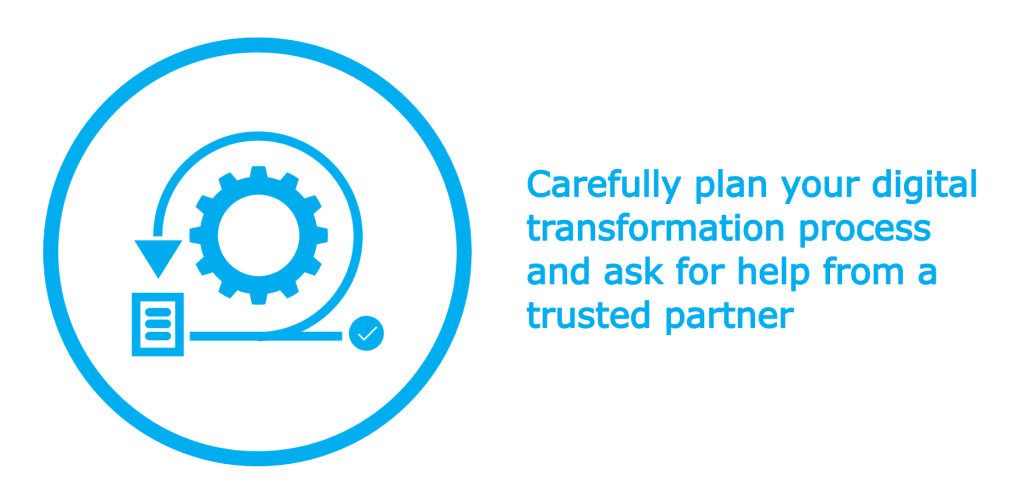Organizations are closely observing the digital transformation process with a keen eye, recognizing it as a crucial avenue for growth and viability in today's swiftly evolving market. Nevertheless, as highlighted by Tomasz Dziki, Vice President of Britenet, the journey from conception to execution is fraught with challenges. In this interview, we will delve into the hurdles that may impede progress along this transformative path.
Digital transformation, despite being associated with improvements, is not always simple and easy. What are in your opinion the most common obstacles that arise when implementing new solutions in a company? Is there a situation where digitalisation is unsuccessful?
When carrying out a digital transformation in an organization, we need to realize that the path from idea to implementation is far from straightforward. It requires the right amount of willingness and determination from everyone involved. If we try to implement a particular solution and do not get approval from the board, it is difficult to expect the venture to be successful.
There are many areas that can be improved in an organization, but it is impossible to address them all at once. The company may not be able to implement all the solutions at the same time. That is why it is so important to choose exactly what is important so that the right team or partner can be selected and the implementation process can begin. Do not implement digitalisation in several different areas at the same time. Instead, it is advisable to focus on one and carry out the implementation with greater concentration.
The digitalisation process can fail when one proven algorithm solves a specific problem, but at the same time causes additional obstacles in another area. Another reason may be wrong goals. A transformation may be introduced in such a way that it does not become a useful feature, causing users not to use it.

Introducing potential users to a new feature can help them see its usefulness. There may be a perception among employees that the new change threatens their jobs, which may create considerable resistance to the new solution. They may also find that the new value makes their work harder because they are forced to use complex systems.
I used to find documents on my desk that I would review and sign. Today, there is such a feature as an electronic signature. It is so useful that it allows you to sign without having to leave the house. Even so, it takes me less time to come to work and sign manually. Physical documents, unlike their electronic counterparts, allow us to easily review the text and focus on the one that interests us most
Before embarking on a digital transformation, it is worth carefully considering the costs and goals you want to achieve. Reducing budgets, abandoning key elements and implementing technology without thought can prove to be a shot in the knee for an organization.
At the beginning you mentioned the issue of cooperation and the involvement of each party in the organization. What did you mean?
On the one hand, we have enthusiasts who want to implement a particular solution because they see that it can change the world around them. On the other side are those responsible for verifying progress and the KPIs achieved. The technology side is highly motivated to innovate. The IT people try to bring a lot of ideas during the collaboration that can be implemented. That is why it is important to have someone from the business side to identify what is important and what the organization should allocate funds to. Careful selection is necessary here to stop the enthusiasm of the developers. This is one of the more difficult tasks for the business side. If we consider the relationship between supplier and customer, it is clear that the technology company aims to sell as many of its services as possible. However, whether this will bring a specific benefit to the customer should be assessed by the customer themselves, regardless of previous promises.
Is it worth using an external partner for the above issues? To what extent can the supplier help us?
A technological company can be helpful. It is more up-to-date in some areas than the organization's IT department itself, especially if it is more specialized. Thus, it can support the IT department by bringing information on the latest available solutions and proposing different concepts of action. Nevertheless, the supplier cannot be expected to understand the business better than the customer and be able to decide which areas are most critical for the customer. However, it can help identify these areas.This is our regular part of IT consulting at Britenet.
Do the public and private sectors differ in terms of digitalisation? What solutions are popular in one sector and the other?
The public sector was somewhat behind the commercial sector in terms of digitization. Now the situation has changed. Solutions are emerging, such as apps that allow us to handle and use digital documents or the ability to fill out tax returns online. The current tax form is filled in largely automatically. I believe that the public sector has the potential for digitalisation and digitisation.
A visit to the office is now a much more enjoyable experience. Nowadays, the main task of officials is no longer to fill in forms and rewrite data. Their role is now to assist citizens with their affairs at the office. For new application forms, we can complete and submit them online. Recently I managed to do this in just a few minutes, which saved me a lot of time. I believe that the digitalisation of the public sector, by making it easier for citizens to interact with the country, is developing significantly. In the private sector, the situation is quite different. The main goal of private companies is to generate profits, and their priorities are shaped differently.
If we were to compare Poland with the rest of Europe, what is the current technological level of the country?
If you look at the public sector, it looks pretty good. Many processes have already gone through the automation stage, which makes it easier for us to implement them. In the area of banking, we also have a number of modern solutions at our disposal, and contactless payments are easy to implement. In this and many other aspects, we can boast of a level of sophistication. However, if we focus on innovation and how to integrate technology into everyday life, the situation does not look so good compared to the truly developed countries. Poland has not yet created solutions that have managed to revolutionize the world. Nevertheless, we have highly qualified specialists, and universities train programmers at a good level. In the area of banking technology and mobile internet we are at a high level. The popular Polish chain of grocery stores is also introducing more and more modern solutions. Courier services are also gaining more and more recognition. Nevertheless, in Poland there are still many areas where technology could be used more effectively, but for various reasons we do not use it.
Are there some recurring issues that suppliers often encounter during their digital transformation projects? What should both sides of the cooperation expect?
The most common problem is that when a customer decides to purchase a given service from us, it seems to them that unexpectedly everything will work immediately. They expect the entire responsibility to rest on the IT provider. A key element of the success of any IT project or digital transformation is an engaged customer who is aware of their goals and is ready to make changes in their business. My experience shows that every successful project had a strong representative from the client side who felt the owner of the project and actively participated in it. Such a person could lead an open discussion about how to implement the transformation. So what can a client expect from a partner? First of all, the partner should have a deep knowledge of technology and an understanding of general business processes. You can’t expect a partner to know the client’s goals in advance. The IT provider can bring many valuable ideas to the project, but the client must be able to define what the success of the project means to them. Above all, good cooperation, commitment, and decision-making skills are expected from the partner. Transformation processes are complex and their effectiveness depends on the active participation of the client.
What attitude should an organization present if it wants to successfully go through the whole process of digital transformation? Does it have to set specific goals?
The organization should clearly define its priorities and the goals it wants to achieve in the digital transformation process. Having set objectives will make it easier to monitor progress and assess whether a project is moving in the right direction.
A good example of a successful transformation is the decision of one of the major Polish banking institutions to place its historic facility in metaverse, i.e. a virtual, three-dimensional world. With this procedure, the institution intended to show that their offer is also aimed for a younger group of recipients. The bank broke the stereotype of being mainly associated with older clients. It was also intended to show that the bank is oriented towards modernity.
Successful digital transformation is therefore about setting a goal and consistently pursuing it. The transformation has not only changed the image of the organization, but also influenced its perception, especially among younger social groups.



